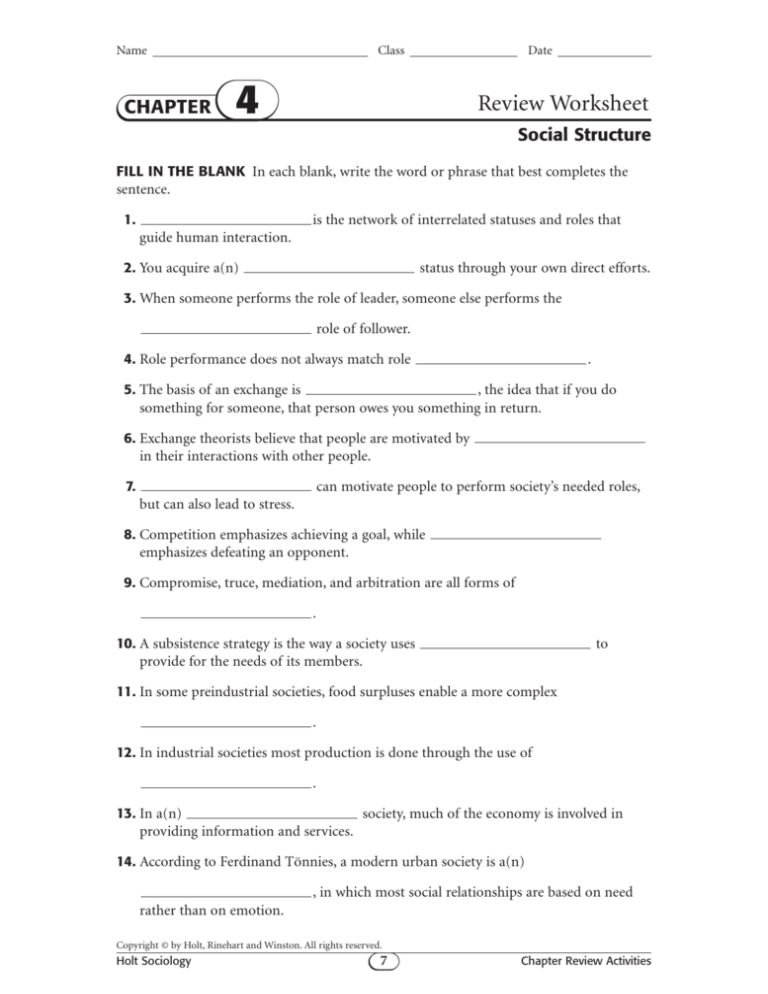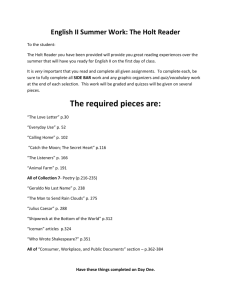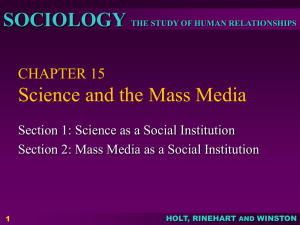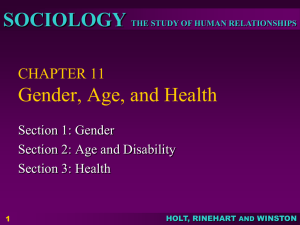
Name
CHAPTER
Class
Date
4
Review Worksheet
Social Structure
FILL IN THE BLANK In each blank, write the word or phrase that best completes the
sentence.
1.
is the network of interrelated statuses and roles that
guide human interaction.
2. You acquire a(n)
status through your own direct efforts.
3. When someone performs the role of leader, someone else performs the
role of follower.
4. Role performance does not always match role
.
5. The basis of an exchange is
, the idea that if you do
something for someone, that person owes you something in return.
6. Exchange theorists believe that people are motivated by
in their interactions with other people.
7.
can motivate people to perform society’s needed roles,
but can also lead to stress.
8. Competition emphasizes achieving a goal, while
emphasizes defeating an opponent.
9. Compromise, truce, mediation, and arbitration are all forms of
.
10. A subsistence strategy is the way a society uses
provide for the needs of its members.
to
11. In some preindustrial societies, food surpluses enable a more complex
.
12. In industrial societies most production is done through the use of
.
13. In a(n)
society, much of the economy is involved in
providing information and services.
14. According to Ferdinand Tönnies, a modern urban society is a(n)
, in which most social relationships are based on need
rather than on emotion.
Copyright © by Holt, Rinehart and Winston. All rights reserved.
Holt Sociology
7
Chapter Review Activities
Chapter 4, Chapter Review Activities, continued
SHORT ANSWER Answer the questions in the space provided.
15. What are four major features of a group?____________________________________
16. Are fans filling the seats at a football stadium a group? Explain. __________________
17. Is decision making easier in a dyad or triad? Why? ____________________________
18. How might your sociology class include both primary and secondary relationships?
19. Suppose your friendship group is studying for an exam together. Tanya devised a set
of flash cards to help you study. Rahib brought brownies and soft drinks. What
functions are Rahib and Tanya serving in the group? Explain. ___________________
20. According to Max Weber’s model, what are five characteristics of bureaucracies?
21. Why did workers at the Hawthorne, Illinois, plant not do as management expected?
22. What is the “iron law of oligarchy”? ________________________________________
Copyright © by Holt, Rinehart and Winston. All rights reserved.
Holt Sociology
8
Chapter Review Activities
the feelings of others, and aggressive
behavior is discouraged. The
Mundugumor carry their infants in rigid
baskets that give no contact with the
mother. The mother feeds them when she
is ready. Children are not picked up or
comforted. Children live in a world of
rules and receive slaps and other physical
punishment for violating these rules.
3.
4.
5.
6.
7.
reciprocal
expectations
reciprocity
self-interest
Competition
8. conflict
9. accommodation
10. technology
11. division of labor (or specialization)
12. machines
13. postindustrial
14. Gesellschaft
15. (1) A group must consist of two or more
people. (2) There must be interaction
among members. (3) The members must
have shared expectations. (4) The members must posses some sense of common
identity.
16. No. The fans are an aggregate, not a
group, because they lack organization or
lasting patterns of interaction.
17. Decision making is easier in a triad. In a
dyad, if the two members fail to agree, one
member must convince the other to
change his or her mind. In a triad, twoagainst-one alliances can form in cases of
disagreement.
18. The students and teacher in your sociology class form a secondary group organized around specific goals. Within the
class, however, you may have close friends
who are part of your primary friendship
group.
19. Tanya is the instrumental leader. She is
task-oriented and found a specific means
that will help the group reach its goal of
getting a good grade on the exam. Rahib is
the expressive leader. He brought refreshments to boost morale while the group
works.
20. Weber's model identifies these characteristics of bureaucracies: division of labor,
ranking of authority, employment based
on formal qualifications, rules and regulations, and specific lines of promotion and
advancement.
21. Management assumed that each worker
would try to complete as many units as
possible in order to make more money.
However, an informal structure developed
among the workers. Together, they set
20. Based on her research, Mead concluded
that temperament is mainly the result of
culture rather than biology.
21. Cultural relativism is the belief that
cultures should be judged by their own
standards rather than by applying the
standards of another culture. This attitude
helps social scientists keep an open mind
toward cultural variations. It helps them
understand practices that seem strange or
different from those of their own culture.
22. Most subcultures do not reject all of the
values and practices of the larger society
or present a threat to society. A counterculture, on the other hand, has practices
intended to challenge the values of the
larger society. A group may reject the
major values, norms, and practices of the
larger society and replace them with a new
set of cultural patterns.
Chapter 3
CULTURAL CONFORMITY
AND ADAPTATION
1. i
12. l
13. a
2. h
3. m
14. g
4. e
15. f
5. k
16. c
6. h
17. a
7. b
18. b
8. n
19. d
9. d
20. c
10. c
21. b
11. o
22. a
Chapter 4
SOCIAL STRUCTURE
1. Social structure
2. achieved
Copyright © by Holt, Rinehart and Winston. All rights reserved.
Holt Sociology
38
Chapter Review Activities
norms for a day's production. They
enforced these norms with sanctions. The
informal structure was more important
than the formal structure to the individual
workers.
22. According to Robert Michels, the iron law
of oligarchy is the tendency of organizations to become increasingly dominated
by small groups of people.
Chapter 5
SOCIALIZING THE INDIVIDUAL
11. generalized other
l. d
2. c
3.a
4.
5.
5.
7.
8.
9.
10.
b
d
c
socialization
personality
looking-glass self
primary
12.
13.
14.
15.
16.
17.
18.
19.
20.
I
me
family
deliberate
Peer
school
mass media
total institution
Resocialization
12. Negative consequences that are more
likely for teenage pregnancies include
lower birth rates, infant death, death of
the mother during childbirth, lower
educational attainment for the parents
and thus lower lifetime earnings, learning
difficulties among the children, and risk
of the children becoming teen parents
themselves.
13. Key factors in teen drug use are having
friends who regularly engage in drug use,
having social and academic adjustment
problems, and living in a hostile and
rejecting family setting.
14. The factors identified by researchers
Neiger and Hopkins include alcohol or
drug use, triggering events, age, sex,
population density, family relations, and
the cluster effect.
Chapter 7
THE ADULT IN SOCIETY
Chapter 6
THE ADOLESCENT IN SOCIETY
1. b
4. c
2. d
5. d
3. a
6. d
7. Puberty and acceptance into the adult
world occur at different times for different
people.
8. The three factors are education, exclusion
of youth from the labor force, and development of the juvenile justice system.
9. Pressures come from parental rules,
school, peers, relationships, jobs, and
conflicting roles.
10. The purpose of courtship was eventual
marriage. While dating may lead to
marriage, its main purpose is entertainment and amusement, at least in the
casual stages.
11. Contemporary dating is informal and has
no set stages. It involves flexibility and
greater equality between the sexes.
Relationships are based on friendship, and
the group—rather than the couple- is the
most important focus of interaction.
1. The most important task of men in the
early adult transition period is leaving
home, both physically and psychologically.
2. Men develop a dream of adult
accomplishment, almost always phrased
in terms of occupational goals and often
unrealistic.
3. A mentor is someone who fosters an
individual's development by believing in
the person, sharing the person's dreams,
and helping the person achieve those
dreams. Usually the mentor is an older,
experienced person in the world of work.
The mentor acts as a role model and helps
the individual get started in adult life.
4. The three phases are leaving the family,
entering the adult world, and entering the
adult world again.
5. Female development is different from
male development in women's emphasis
on marriage over career in Phase I, in the
break in employment that occurs during
Phase II, and in women's commitment to
their careers in Phase III at a time when
men are beginning to have serious doubts
about their own careers.
Copyright © by Holt, Rinehart and Winston. All rights reserved.
Holt Sociology
(39)
Chapter Review Activities












